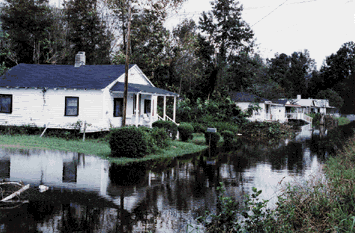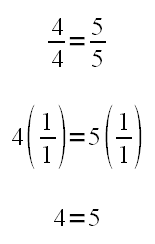“After I’m dead I’d rather have people ask why I have no monument than why I have one.” — Cato the Elder
Author: Greg Ross
Proof That 4 Equals 5
In the Old Days, We Made Our Own Fun
“The Travelling Egg”
Procure a goose’s egg, and after opening and cleaning it, put a bat into the shell, and then glue a piece of white paper fast over the aperture. The motions of the poor little prisoner in struggling to get free, will cause the egg to roll about in a manner that will excite much astonishment.
— Samuel Williams, The Boy’s Treasury of Sports, Pastimes, and Recreations, 1847
“How to Melt Steel”
Heat a piece in the fire till it is red hot; then holding it with a pair of pinchers or tongs, take in the other hand a stick of brimstone, and touch the piece of steel with it; immediately after the contact, you will see the steel melt and drop like a liquid.
— “Uncle George,” Parlour Pastime for the Young, 1857
“The Gun Trick”
Provide yourself with a fowling piece or musket; permit any one to load it, only retaining for yourself the privilege of putting in the ball. But instead of loading it with a real ball, retain the latter in your possession, having had a recognisable mark put upon it, and load with an artificial one made of black lead. On the application of the ramrod the latter will, of course be easily reduced to powder. When you are fired at, you produce the marked ball, holding it between your thumb and finger.
— Alfred Elliott, The Playground and the Parlour, 1868
Quadrennial
The French newspaper La Bougie du Sapeur is published only on leap day, Feb. 29 — which means a new issue appears only once every four years.
You can buy a century’s subscription for 100 euros.
Light Reading
Selected winners of the Bookseller/Diagram prize for oddest book title of the year:
- Proceedings of the Second International Workshop on Nude Mice (1978)
- The Joy of Chickens (1980)
- The Theory of Lengthwise Rolling (1983)
- Versailles: The View From Sweden (1988)
- How to Avoid Huge Ships (1992)
- Highlights in the History of Concrete (1994)
- Greek Rural Postmen and Their Cancellation Numbers (1996)
- The Big Book of Lesbian Horse Stories (2003)
- Bombproof Your Horse (2004)
- People Who Don’t Know They’re Dead: How They Attach Themselves to Unsuspecting Bystanders and What to Do About It (2005)
- The Stray Shopping Carts of Eastern North America: A Guide to Field Identification (2006)
Last year’s winner, The 2009-2014 World Outlook for 60-Milligram Containers of Fromage Frais, is the subject of some controversy, as it was written by an automatic authoring machine rather than a human being. But, said awards administrator Philip Stone, “Given the number of celebrity memoirs out there that are ghostwritten, I don’t think it’s too strange.”
Tarzan Down
Where do SWINGER and PYGMIES have the same meaning?
On a telephone keypad.
The Bystander Paradox

You and I are walking through a dark alley. You are explaining that it’s wrong to kill an innocent person, but that it’s morally permissible to kill someone who is threatening your life.
At that moment an attacker leaps out of the shadows — and you find that, because of my position, you cannot defend yourself without also killing me.
In that instant, what is your moral obligation? You must not kill an innocent man. But my presence is threatening your life, so in that sense I am not innocent and can be sacrificed.
But if there’s no imperative to spare my life, then I’m no longer a hindrance to your self-defense … in which case I’m innocent again and you’re not justified in killing me.
And so on.
Ships and Meteorites
The following account of unusual phenomena was received March 10, at the Hydrographic office, Washington, from the branch office in San Francisco. The bark Innerwich, Capt. Waters, has just arrived at Victoria from Yokohama. At midnight of Feb. 24, in latitude 37° north, longitude 17° 15′ east, the captain was aroused by the mate, and went on deck to find the sky changing to a fiery red. All at once a large mass of fire appeared over the vessel, completely blinding the spectators; and, as it fell into the sea some fifty yards to leeward, it caused a hissing sound, which was heard above the blast, and made the vessel quiver from stem to stern. Hardly had this disappeared, when a lowering mass of white foam was seen rapidly approaching the vessel. The noise from the advancing volume of water is described as deafening. The bark was struck flat aback; but, before there was time to touch a brace, the sails had filled again, and the roaring white sea had passed ahead.
— Science, March 20, 1885
A narrow escape from destruction by an immense meteor was reported this morning by officers of the steamer Cambrian, which arrived from London. The huge fiery mass struck the water within fifty yards of the Cambrian’s starboard bow last Friday evening when the ship’s position was longitude 51.10 west, latitude 42.05 north, several hundred miles south of Cape Race.
[Third officer Daniel Vittery:] ‘The air was filled with a deafening din such as a thousand railroad trains in a tunnel might create. The hiss of dropping fragments gave me the fleeting impression of the ship’s boilers leaking in every plate. … With a crash that shook the ship the monster struck the sea not fifty yards away, and the upheaval was terrific. Not a rope nor a spar was scathed when the meteor, big as a fair-sized house, went squarely over us and struck the sea.’
— The Friend, Sept. 21, 1907
The Sorites of Themistocles
My infant son rules his mother.
His mother rules me.
I rule the Athenians.
The Athenians rule the Greeks.
The Greeks rule Europe.
And Europe rules the world.
Thus my infant son rules the world.
Good Boy

The gold medal for canine endurance goes to Petey, the junkyard dog who guarded Al’s Auto Salvage in New Bern, N.C., in 1996. Petey was only 10 inches tall, and when Hurricane Fran roared up the North Carolina coast on Sept. 5, he was locked in a building that flooded with 16 inches of water.
Owner Skip Crayton feared the worst, but when he opened the shop the following morning, out came Petey, covered up to his neck in oil and mud. Apparently the dog had swum continuously for six to eight hours in the flooded building, keeping his head just above water to stay alive.
Petey couldn’t tell of the experience, of course, but when Crayton got him home he slept for two days.
See also The Dog of Pompeii.

